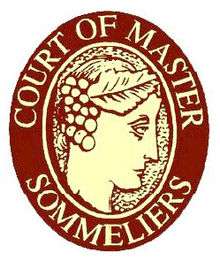Court of Master Sommeliers
 | |
Region | Worldwide, The Americas |
|---|---|
| Website | www.courtofmastersommeliers.org |
The Court of Master Sommeliers (CMS) is an organisation established in April 1977 to encourage improved standards of beverage service, particularly wine and food pairing, in hotels and restaurants.
The first Master Sommelier examination was held in the United Kingdom in 1969; the Court of Master Sommeliers was later established as an international examining body for sommeliers. It was set up under the supervision of the Vintners Company, The Institute of Masters of Wine, The British Hotels & Restaurants Association, The Wine & Spirit Association of Great Britain, and The Wholesale Tobacco Trade Association.[1]
Their standards and examinations today are recognised internationally.
American chapter
In 1986 the first Master Sommelier exams were held in the US and the American Chapter of the CMS was established under the name 'Court of Master Sommeliers Americas'. The American Chapter of the CMS also provide examinations in Canada.
Education and certification

The court has four levels of certification that grow in depth and complexity with each level.[2] Those who achieve each level are awarded a certificate and badge on the same day as the exam.
Level I – Introductory
Open to anyone with several years experience in the restaurant industry, this level consists of two days of classes followed by a multiple choice exam that typically has a 90% pass rate. Topics covered include but are not limited to: elementary wine making procedures, grape varieties, and matching wines with food. Passing the Introductory Sommelier Course does not confer the "Sommelier" professional title.[3]
Level II – Certified Sommelier
This level was created in December, 2005 to bridge the exponential increase in knowledge, experience and difficulty between the Introductory and Advanced levels.[4] It is open to those who have passed the Introductory level and focuses a great deal more on service and more in depth knowledge of the world of wine. It consists of an exam with three parts: theoretical consisting of multiple choice and short answer questions, a written blind tasting of four wines (two white and two red), and service. The pass rate is generally around 60%.[5]
Level III – Advanced Sommelier
This level requires having passed the Certified exam and the Advanced Sommelier Course as well as a significant increase in knowledge and experience for those wishing to attain it. The three day Advanced Course is offered twice per year, usually in the spring and summer, and requires the candidate to first submit an application and take a timed knowledge survey. There is a heavier focus on service and a more intimate knowledge of all wine styles and regions as well as wine producers themselves is required. The Court generally recommends 1–2 years of preparation after successfully passing the Certified exam. The Advanced exam is generally offered three times per year and consists of a longer, written theoretical test that is mostly short answer questions, a blind tasting of six wines given orally to a panel of Master Sommeliers, and a much more intense service exam. The pass rate is usually 30%.[6]
Level IV – Master Sommelier
The top level of the sommelier trade, those who wish to take this exam must have passed the Advanced exam, be invited and/or recommended to sit the exam and have typically worked in the industry for at least 10 years. The exam covers all aspects of the world and industry of wine, beer, spirits/cocktails, and hospitality from a business, service and philosophical approach. The three part, oral exam consists of theory (must be passed before taking the other two parts), blind tasting six wines before a panel, and service. Once the first portion is passed, a candidate has three years, including the first attempt, to pass all three portions i.e. a candidate can pass one part each year for three consecutive years and successfully become a Master. If all three parts are not passed in the three year window the candidate resets to zero and must retake all parts. This exam has a pass rate of less than 1% and it is common for many Sommeliers to make five or more attempts before finally achieving success.[7]
Notable Master Sommeliers
- İsa Bal
- Robert Bath
- Gerard Basset
- Wayne Belding
- Ian Cauble
- Niall Clancy
- Craig Collins
- Fred Dame
- Jay Fletcher
- Sara Floyd
- Tim Gaiser
- Cale Hoffman
- Claire Thompson
- Bryan Julyan
- Frank Kämmer
- Andrew McNamara
- Franck Moreau
- Kevin Reilly
- Ronan Sayburn
- Ricardo Spínola
- Larry Stone
- Dustin Robert Abel Hays
- Jeremy Hays
- Kevin M. Vogt
See also
References
- ↑ Robinson, Jancis, jancisrobinson.com (June 29, 2005). "Master Sommeliers – who are they?".
- ↑ "Court of Master Sommeliers Qualifications".
- ↑ "Court of Master Sommeliers Introductory".
- ↑ Taking the Court of Master Sommeliers Level 2 – Certified Sommelier Exam
- ↑ "Court of Master Sommeliers Certified".
- ↑ "Court of Master Sommeliers Advanced".
- ↑ "Court of Master Sommeliers Master".